
The Pannariaceae are a family of lichens in the order Peltigerales. Species from this family have a widespread distribution, but are especially prevalent in southern temperate regions.

Ramalina is a genus of greenish fruticose lichens that grow in the form of flattened, strap-like branches. Members of the genus are commonly called strap lichens or cartilage lichens. Apothecia are lecanorine.
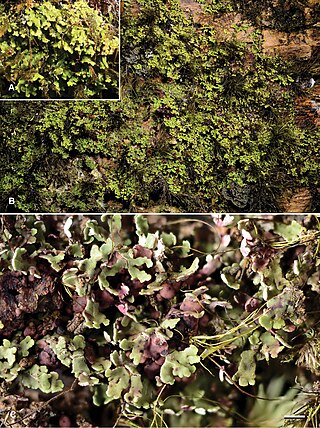
Krogia is a genus of corticolous lichens in the family Ramalinaceae. It occurs in tropical humid forests and rainforests. The genus was circumscribed by Norwegian lichenologist Einar Timdal in 2002, with Krogia coralloides assigned as the type species.
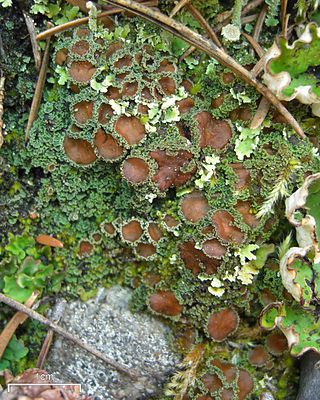
Psoroma is a genus of lichenized fungi in the family Pannariaceae. The genus was circumscribed by French botanist André Michaux in 1803. The widespread genus contains an estimated 58 species, most of which are found in south temperate regions. Some species formerly in Psoroma were transferred to the new genera Psorophorus and Xanthopsoroma in 2010. The genus Joergensenia was erected in 2008 to contain the species formerly known as Psoroma cephalodinum.

Protopannaria is a genus of seven species of lichenized fungi in the family Pannariaceae. The genus was originally circumscribed as a subgenus of the genus Pannaria by Hungarian lichenologist Vilmos Kőfaragó-Gyelnik. Per Magnus Jørgensen and Stefan Ekman promoted Protopannaria to full status as a genus in 2000.
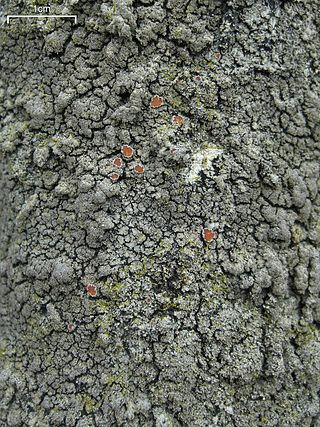
Parmeliella is a genus of lichenized fungi in the family Pannariaceae. It occurs mainly in the tropics and sub-tropics, with species found in Africa, Asia, Australasia and South America. A recent (2020) estimate places 41 species in the genus.

Pannaria is a genus of lichen-forming fungi in the family Pannariaceae. The widespread genus contains an estimated 51 species, found primarily in tropical regions.
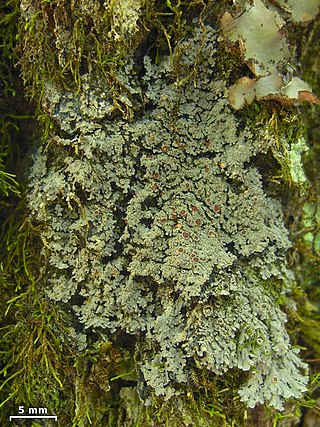
Fuscopannaria is a genus of lichen-forming fungi in the family Pannariaceae. It has 55 species.
Fuscoderma is a genus of lichenized fungi in the family Pannariaceae. It was originally circumscribed as a subgenus of the genus Leioderma by David Galloway and Per Magnus Jørgensen in 1987. The same authors promoted it to generic status a couple of years later in 1989. The New Guinean species F. papuanum was added to the genus in 2002.

Degelia is a genus of lichen-forming fungi in the family Pannariaceae. The genus is named after Swedish lichenologist Gunnar Degelius.
Hildur Krog was a Norwegian botanist.
Peter Wilfred James (1930–2014) was an English botanist and lichenologist. He was a pioneer in the study of lichens as environmental indicators, especially of atmospheric pollution.
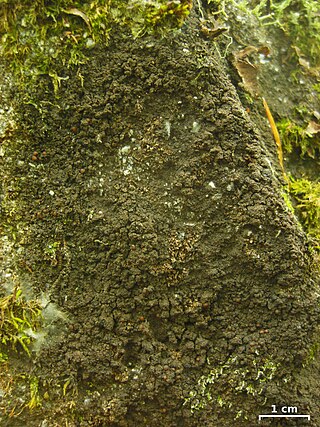
Vahliella is a genus of nine species of lichen-forming fungi in the order Peltigerales. It is the only member of Vahliellaceae, a family circumscribed in 2010 to contain this genus. Vahliella was formerly placed in the family Pannariaceae until molecular phylogenetics showed that it did not belong there. Vahliella species are found in the Northern Hemisphere – mainly in North America, but also in Europe and India.
Per Magnus Jørgensen is a Norwegian botanist and lichenologist, and Professor Emeritus of systematic botany at the University of Bergen. He is known for his work on the lichen families Pannariaceae and Collemataceae. Jørgensen was awarded the Acharius Medal in 2021 for his lifetime contributions to lichenology.
Muhria is a lichen genus in the family Cladoniaceae. It is monotypic, containing the single species Muhria urceolata. The genus was circumscribed by Norwegian lichenologist Per Magnus Jørgensen in 1987. The genus name of Muhria is in honour of Lars-Erik Muhr (b.1936), a Swedish teacher and botanist.
Rockefellera is a fungal genus in the family Pannariaceae. It is a monotypic genus, containing the single species Rockefellera crossophylla. The genus was circumscribed by James Lendemer and Erin Tripp in 2017. The generic name honors the Rockefeller family, "for their century-long support of North American conservation efforts, particularly with respect to national parks."

Lepidocollema marianum is a species of cyanolichen in the family Pannariaceae. It was first scientifically described by Elias Fries in 1825 as Parmelia mariana. Per Magnus Jørgensen transferred it to the genus Lepidocollema in 2014 following a molecular phylogenetics-guided revision of the Pannariaceae.
The British Lichen Society (BLS) was founded in 1958 with the objective of promoting the study and conservation of lichen. Although the society was founded in London, UK, it is also of relevance to lichens worldwide. It has been a registered charity since 1964.
Fuscopannaria granulifera is a species of squamulose (scaley), corticolous (bark-dwelling) lichen in the family Pannariaceae. Found in India, it was formally described as a new species in 2004 by Norwegian lichenologist Per Magnus Jørgensen. The type specimen was collected from the Great Himalayan National Park at an elevation of 3,140 m (10,300 ft). It is only known to occur in the upper forests of western Himalayas. F. granulifera is the only corticolous member of its genus that has a green algal photobiont; all others have a cyanobacterial photobiont.
Thomas Douglas (Dougal) Victor Swinscow (1917–1992) was the founder of the British Lichen Society and the scientific journal The Lichenologist. He was also a member of the editorial team of the British Medical Journal and deputy editor from 1964 until 1977.









